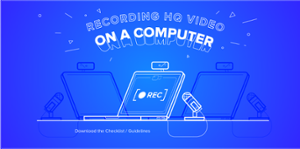
Netflix. Hulu. Amazon Prime Video. HBO Go. Disney Plus. YouTube TV. Apple TV Plus. IMDb TV. CBS All Access. Twitch.
It feels as if there are as many online streaming services as there are TV channels on traditional cable, these days.
The way people consume video is changing. 20% of U.S. households have cut the cord. 62% of Americans subscribe to a streaming service.
Not only are people watching pre-recorded content online, but they are still tuning in to watch live events as well, whether it’s their local TV news station or their favorite celebrity going live on Instagram and Facebook. A survey found more than two-thirds of consumers globally have streamed live video content.
With this, (and as a response to COVID-19) we’re seeing the rise of virtual events.
Virtual events allow people from all over the world to take part. With that comes the challenge of engaging and delighting your audience without the energetic atmosphere that you get with in-person events.
So, how do you host dynamic, attention-grabbing virtual events?
It all comes down to the content and how it’s delivered. This is where choosing between pre-recorded content and live-streaming can make a big difference in the success of your event.
This article will look at the pros and cons of pre-recorded content and live-streaming, including how technology plays a huge role in wowing your audience.
What is a Virtual Event?
To put it simply, virtual events are online versions of live corporate events. Keynote presentations, panel discussions, product reveals, and breakout sessions are all live-streamed over the Internet rather than being held in a physical location.
Instead of traveling to the event, attendees click on it and watch the presentations from the comfort of their home or office.
FREE DOWNLOAD: VIRTUAL EVENT PLANNING CREATIVE BRIEF
The Benefits of Hosting a Virtual Event
Sure, there are some aspects of virtual events that can’t compete with live events, such as audience reaction and participation and in-person networking opportunities. However, there are still plenty of benefits to hosting a virtual event.
The main selling point of virtual events is its reach. Since the event is offered online, virtually anyone in the world can attend.
People may even be more likely to attend because it’s cheaper. Instead of having to pay for airfare, lodging, and food on top of admission to the event itself, virtual event attendees only have to pay for admission.
Virtual events also cost less for the people/businesses putting them on since they don’t need to host dozens, hundreds, or thousands of people. They also might not need as many staff members involved in hosting a virtual event, which can free up people to focus on other projects.
Pre-Recorded Versus Live-Streaming
One of the bigger considerations for a virtual event planner is whether or not to have the on-camera presentations done live or have them pre-produced. There are arguments for both sides.
Live-streaming allows for more organic, human interaction while pre-recording generally assures the event goes off without a hitch.
You can also mix and match pre-recorded content with live-streaming portions to find the perfect balance for your event.
Benefits of Live-Streaming Virtual Events
As with just about anything in life, there are pros and cons to live-streaming a virtual event. Here’s a look at the positives.
- Immediacy
There's something to be said for that feeling that you’re watching something as it’s happening. There’s more of a connection. It feels more human.
- Interaction
With today’s streaming platforms, the presenter can use any number of apps to interact with their audience, asking questions, taking polls, playing games. Live-streaming itself is inherently about community.
- Cost
More often than not when doing a live streaming presentation, there aren’t a lot of extra bells and whistles. Depending on how grassroots you want to go, it can take as little as a smartphone or laptop with a camera and an active account with a streaming platform. Can a live-streamed presentation have high production values? Certainly, but they are more often the exception than the rule.
Most live-streamed presentations are simply a person or people talking. The production values are virtually non-existent. Case in point: TED Talks. But some larger enterprise businesses are known for investing a pretty penny in their keynote presentation aesthetics. Companies like Microsoft, Apple, and Amazon aren't shy about investing in their biggest events with projection mapping technology, massive LED panel displays, elaborate lighting and visual pyrotechnics that would rival a stadium rock concert. Spending a quarter to half a million dollars for such a display may be in the minority, but certainly isn’t unheard of.
- Time
Although there is always substantial time invested in a presentation—research, sourcing assets, rehearsal—live-streamed content requires less time because there’s generally less production involved. There’s a big reason some content is pre-produced; it’s because the presentation requires more heavy lifting, more production values, which takes time to execute.
Benefits of Pre-Recorded Content for Virtual Events
The pros of pre-recording content for virtual events are essentially the cons of hosting a live virtual event. Pre-recorded content requires more planning and pre-production but eases the stress level when it comes to executing the event itself since there are fewer things that could go wrong.
- Retakes
One thing about doing a presentation live is that what you see is what you get. Warts and all. The presenter screws up? It’s live. The computer running the slide deck malfunctions? It’s live. The speaker’s microphone cuts out? It’s live. With pre-produced content, you get take two, and three, and four, and more if necessary.
- Flexibility
You have more control over how the content is being presented. Want your audience to see the presenter and an accompanying animation at the same time? Want the presenter interacting with the animation? Perhaps with objects and characters zipping around and behind them? You can do that if it’s pre-produced.
- Wow factor
With virtual presentations, you have the unique opportunity to merge the best elements of an in-person live event with a full slate of technical and creative broadcasting tools. And post-production— motion graphics, special effects, sound effects, music— makes everything look better because you have the time and tools to polish the presentation to a high sheen.
How to Uplevel Your Virtual Event with Technology
Today’s technology is leaping forward at an order of magnitude. What wasn’t possible only a few years ago is now mind-bendingly possible today. For example, with the latest AI emotional recognition breakthroughs, presenters can collect even the most minute facial expression data to determine how engaged their audience is at any particular moment.
It’s not uncommon for keynote presentations to be so captivating that they’re actually shared. A far cry from the tedious PowerPoint presentations of years gone by.
Here are some methods to make your presentation one the audience won’t forget.
READ: 4 DYNAMIC VIRTUAL EVENT PRESENTATION IDEAS
Green Screen
There is, of course, the requisite green screen capabilities where the talent is shot in front of a bright, green backdrop, and then the green color is isolated, removed, and replaced with a different background. This effect is also known as chroma key.
This technology has been around for decades but is still improving and is an effective tool for upping production values.
You can shoot green screen live—weather forecasters do it every day on the news—but it’s best if pre-produced where you can really fine-tune the key. Want to make it look like your presenter is in a high-tech lab, or in Paris, or on the moon? Green screen allows you to do that.
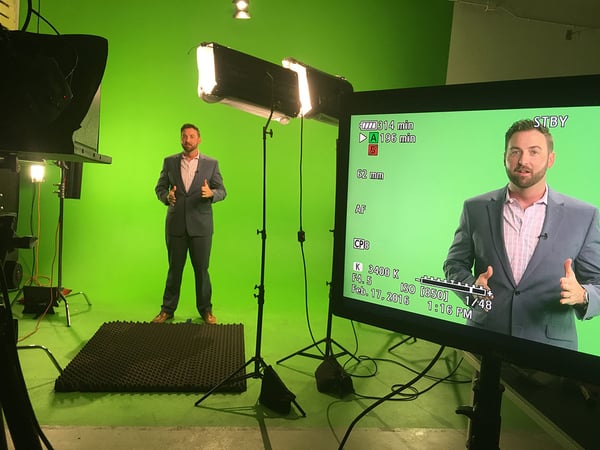
3D Projection Mapping
Projection mapping uses projectors pointed at architecture and objects to change their visual nature. When the content is fed to the projectors, it perfectly lines up with the object and appears to “wrap” it in amazing texture and imagery. Imagine it as magical paint that can coat any object with images.
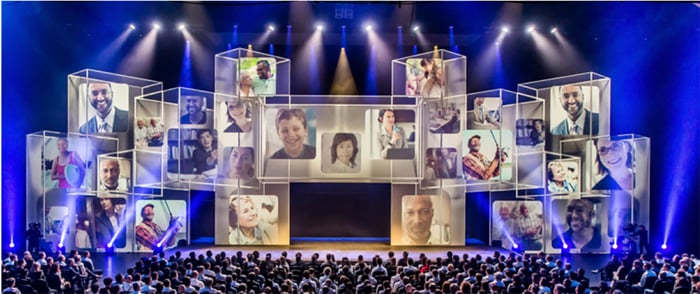
This is an exciting and visually stunning technology that can be used at any scale. This effect can be done live, in real-time. However, there is a tremendous amount of pre-production that goes into it. All the graphics and imagery have to be built in advance. 3D projection mapping is commonly used on stage at concerts and larger corporate events.
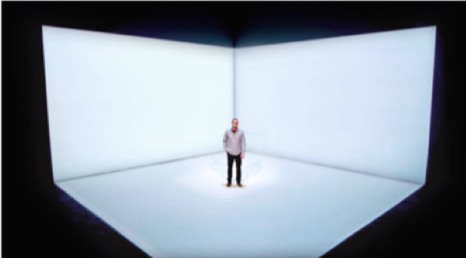
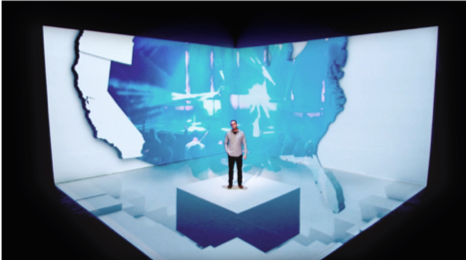
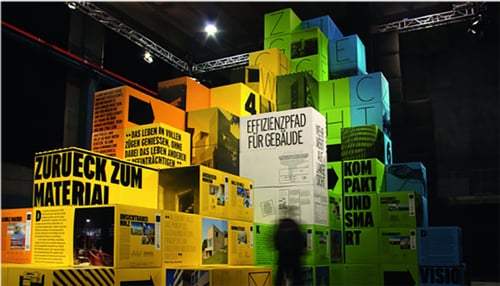
Mixed or Extended Reality
This is a next-generation process for film, broadcast, and live event production. It combines camera tracking with real-time rendering on an immersive LED set to create an incredible environment that responds and tracks with a presenter.
While the camera moves, the environment on the set moves with it, perfectly in sync. It looks like the talent is in the actual environment. Unlike a green screen, the talent can react to changes in their environment because they can actually see the changes taking place around them.
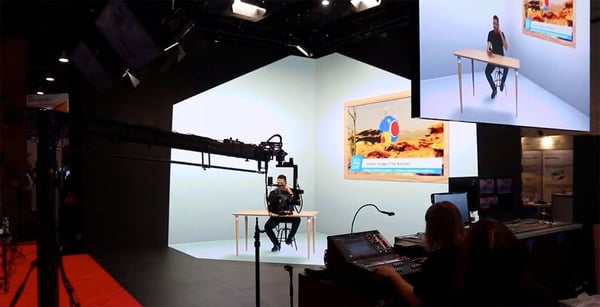
This can be used live, but like 3D projection mapping, it takes a great deal of pre-production. It’s also very expensive. You can easily spend upwards of mid-six-figures for this technology. But it’s this type of production value that can separate your virtual event from the pack.
It’s this kind of eye candy that takes a virtual keynote presentation to new heights and makes it sharable content. It’s so visually stunning that people will post it to their social media pages with the caption, “You’ve got to see this!” When it comes to event presentation, this technology is at the top of the food chain.


Moving Forward with Virtual Events
The fact that attendees are experiencing an event on a computer or mobile device instead of in-person may seem like a lesser experience, but it doesn’t have to be.
Virtual events are gaining in popularity due to the myriad and creative ways of capturing and presenting content.
As with most any project, your decision as to whether to have your presenters perform live or have their segment pre-produced all comes down to two things: time and money. How much you can invest in either.
VMG Studios can help you in your decision-making process for which option will give you the best results. And production and post-production are our core capabilities. We can be your virtual event presentation turnkey solution.
Learn how to record high-quality video on your home computer by clicking the image below to download a free checklist



